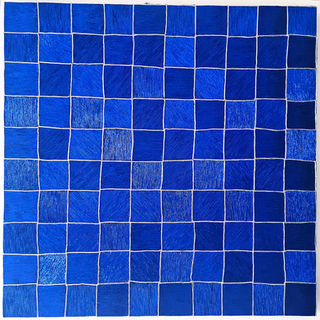
This monochromatic project reinterprets the historical narrative of Korean monochrome painting from a new perspective. While Korean monochrome has often been positioned as a defining symbol of contemporary Korean art, my work critically examines the ways in which its history has been framed and celebrated through a particular lens.
A point of departure is monochrome artists Seo-bo Park’s Écriture series, long regarded as emblematic of Korean monochrome. The origin of Écriture lies in an intimate story: Park observed his young son practicing Korean characters in squared boxes of a notebook. Despite his efforts, the results were unsatisfactory, and in frustration the boy filled the boxes with pencil lines. Park read this gesture as one of despair. Over time, however, critics reinterpreted these lines as the rotation of a Joseon potter’s wheel or as the practice of wu wei—a purposeless but natural repetition. This framing established Écriture as a spiritual and naturalist gesture and placed it firmly within a particular art-historical narrative.
My project seeks to move beyond these established readings. To do so, it is necessary to revisit the context of the 1970s, when Écriture was produced during a period of military dictatorship in South Korea. At that time, freedom of imagination and expression was severely restricted. Within this context, Park’s countless lines—lines that “say nothing”—can also be read as bearing the weight of countless silenced voices. Beneath the surface of repetition, I attempt to trace the suppressed stories of those who could not speak freely.
Building on this critical stance, the project draws inspiration from female monochrome artist Ok-sun Jin, whose repetitive hexahedron drawings symbolized “ordinary humans,” and from Kim Soo-ja, who incorporated everyday materials and jogakbo (Korean patchwork) into her practice. In my work, jogakbo becomes a vital language for expressing historically marginalised and wandering voices. Through the accumulation of repetitive lines, I aim to visualize the individuality of those who have long been unheard. The canvas, understood as a metaphor for society, becomes a portrait of Korea’s unvarnished reality. Ultimately, this project seeks to imbue monochrome painting with a new voice—one that acknowledges both history and those excluded from it.
























